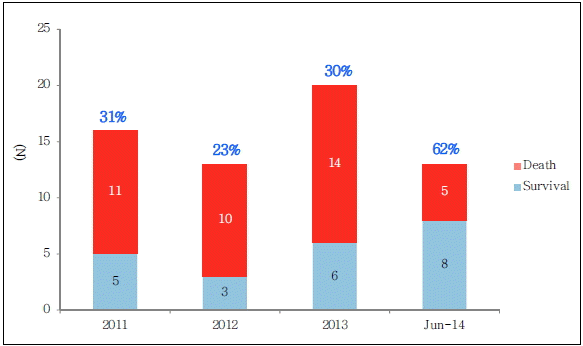Extracorporeal bypass has been used in operating rooms since the 1950s.[1] With the advent of portable extracorporeal systems in the 1980s, extracorporeal membrane oxygenation (ECMO) became available outside the operating room for patients with both medical and traumatic catastrophic cardiopulmonary collapse.[2] ECMO has been introduced domestically via the media, recently garnering attention when it saved a Samsung CEO from cardiac arrest. ECMO is a process which imitates natural gas exchange. In EMCO, blood is continuously pumped from a patient through a membrane oxygenator which removes carbon dioxide and adds oxygen; the oxygenated blood is then returned to the patient. The general criteria for the initiation of ECMO include acute severe cardiac or pulmonary failure that is potentially reversible and unresponsive to conventional management. Clinical use of ECMO has been described in many situations: for cardiogenic shock caused by fulminant myocarditis[3] or acute coronary syndrome,[4] for patients who have undergone cardiopulmonary resuscitation (CPR),[5] for support in the intensive care unit after pulmonary endarterectomy,[6] and in emergency situations (i.e. a completely obstructed airway where tracheostomy was not possible,[7] massive aspiration,[8] lung trauma and pulmonary resection,[9] massive pulmonary embolus,[10] and status asthmaticus[11]). Other uses have included severe burns and smoke inhalation,[12] drug overdose[13] and respiratory failure during pregnancy.[14] Advances in EMCO technology have spurred greater interest and explosive growth, especially during the ‘swine-flu’ (H1N1) epidemic from 2009–2010.[15]
The range of clinical applications for ECMO is gradually growing in Korea as well. In Saint Vincent’s hospital, a secondary care university hospital in Suwon, Korea, ECMO was applied from 2011 to present to a total of 62 patients, and the overall survival rate was 35.5%; the 24 patients with acute coronary syndrome (ACS) had a survival rate of 20.8%, and the 38 non-ACS patients had a higher survival rate (44.7%) (Fig. 1). The fact that survival rate was higher in nonACS patients than in ACS patients was analogous to previous result. Based on this finding, ECMO should be considered to be applied to cardiopulmonary collapse patients with underlying causes other than cardiac origin. EMCO complications such as stroke, peripheral arterial ischemia, bleeding, and infections have recently decreased compared to its initial application; as experience with EMCO builds, the survival rate has shown improvement. Therefore, the frequency of its usage is projected to increase for patients with acute severe cardiac or pulmonary failure. Because ECMO works as a tool to save time for treatment not as a treatment itself, the indications for its use should be cautiously considered. The deliberate application would improve the survival rate. Meanwhile, it is necessary to widely distribute ECMO, for which creating a guideline, educating medical team, and seeking solutions to alleviate the high cost are needed.
Accurate patient selection and a team approach to make the application time short are required for successful implementation of ECMO. However, in order for ECMO to be used in community hospital as a routine rescue modality for catastrophic cardiopulmonary collapse, continued improvements in technology and reduction in equipment costs should be preceded.
References
1). Clowes GH Jr, Neville WE, Hopkins A, Anzola J, Simeone FA. Factors contributing to success or failure in the use of a pump oxygenator for complete by-pass of the heart and lung, experimental and clinical. Surgery. 1954; 36:557–79.
2). Cardarelli MG, Young AJ, Griffith B. Use of extracorporeal membrane oxygenation for adults in cardiac arrest (E-CPR): a meta-analysis of observational studies. ASAIO J. 2009; 55:581–6.

3). Asaumi Y, Yasuda S, Morii I, Kakuchi H, Otsuka Y, Kawamura A, et al. Favourable clinical outcome in patients with cardiogenic shock due to fulminant myocarditis supported by percutaneous extracorporeal membrane oxygenation. Eur Heart J. 2005; 26:2185–92.

4). Sakamoto S, Taniguchi N, Nakajima S, Takahashi A. Extracorporeal life support for cardiogenic shock or cardiac arrest due to acute coronary syndrome. Ann Thorac Surg. 2012; 94:1–7.

5). Chen YS, Chao A, Yu HY, Ko WJ, Wu IH, Chen RJ, et al. Analysis and results of prolonged resuscitation in cardiac arrest patients rescued by extracorporeal membrane oxygenation. J Am Coll Cardiol. 2003; 41:197–203.

6). Berman M, Tsui S, Vuylsteke A, Snell A, Colah S, Latimer R, et al. Successful extracorporeal membrane oxygenation support after pulmonary thromboendarterectomy. Ann Thorac Surg. 2008; 86:1261–7.

7). Willms DC, Mendez R, Norman V, Chammas JH. Emergency bedside extracorporeal membrane oxygenation for rescue of acute tracheal obstruction. Respiratory Care. 2012; 57:646–9.

8). Wetsch WA, Spöhr FA, Hinkelbein J, Padosch SA. Emergency extracorporeal membrane oxygenation to treat massive aspiration during anaesthesia induction. A case report. Acta Anaesthesiol Scand. 2012; 56:797–800.

9). Incagnoli P, Blaise H, Mathey C, Vinclair M, Albaladejo P. [Pulmonary resection and ECMO: a salvage therapy for penetrating lung trauma]. Ann Fr Anesth Reanim. 2012; 31:641–3. French.
10). Omar HR, Miller J, Mangar D, Camporesi EM. Experience with extracorporeal membrane oxygenation in massive and submassive pulmonary embolism in a tertiary care center. Am J Emerg Med. 2013; 31:1612–1620.

11). Ju MH, Park JJ, Jhang WK, Park SJ, Shin HJ. Extracorporeal membrane oxygenation support in a patient with status asthmaticus. Korean J Thorac Cardiovasc Surg. 2012; 45:186–8.

12). Asmussen S, Maybauer DM, Fraser JF, Jennings K, George S, Keiralla A, et al. Extracorporeal membrane oxygenation in burn and smoke inhalation injury. Burns. 2012; 39:429–35.

13). Froehle M, Haas NA, Kirchner G, Kececioglu D, Sandica E. ECMO for cardiac rescue after accidental intravenous mepivacaine application. Case Rep Pediatr. 2012; 2012:1–5.

14). Grasselli G, Bombino M, Patroniti N, Giuffrida A, Marcolin R, Vergani P, et al. Use of extracorporeal respiratory support during pregnancy: a case report and literature review. ASAIO J. 2012; 58:281–4.




 PDF
PDF Citation
Citation Print
Print




 XML Download
XML Download